#John MacRae-Gilstrap
Text
Le château de Eilean Donan, bijou médiéval d'Ecosse
Nouvel article publié sur https://www.2tout2rien.fr/le-chateau-de-eilean-donan-bijou-medieval-decosse/
Le château de Eilean Donan, bijou médiéval d'Ecosse

#brave#chateau#disney#ecosse#Eilean donan#fort#forteresse#highlander#Jacobite#James Bond#John MacRae-Gilstrap#lac#loch duin#medieval#restauration#ruine#vidéo#viking#Walt Disney#architecture#imxok#voyage
2 notes
·
View notes
Text




On August 23rd 1913 work began on the rebuilding of Eilean Donan Castle.
The castle, at Loch Duich was destroyed by the Royal Navy during the minor Jacobite Rising of 1719, when Jacobites and their Spanish supporters garrisoned the stronghold. A number of Spanish soldiers were taken hostage with the remainder fighting at the Battle of Glenshiel in June 1719, which ended in a defeat for the Jacobites.
Eilean Donan Castle, once the traditional seat of Clan Mackenzie, lay a ruin for the next 200 years. Lt. Col. John MacRae-Gilstrap (on the left in the second picture with the kilt) of the MacRae’s of Conchra, the traditional bodyguards to Clan Mackenzie, bought the castle in 1911 and launched the restoration in 1913. The job was to take almost 20 years. Stones, some weighing about 1.5tons, were taken from the hills by Lochlongside and carried to the castle by horse and boat. Those working on the long restoration job were charged with rebuilding walls that were 13-feet deep in parts.
The restoration was praised at a time when Scottish castles were facing wholesale demolition given the rising costs of maintaining such properties. I love the pic of members of the MacRae-Gilstrap family check in on progress - along with the family dog. Lt Col MacRae-Gilstrap was praised individually for his vision and his never-dying love of the Gael…and determination that the clan spirit shall live.
The restoration of Eilean Donan has been described as a “phoenix rising from the ashes. Over two decades, one of the most recognisable landmarks in Scotland took shape.The final piece of the job was adding the now-famous bridge to the island castle.
The opening ceremony on a rainy day in July 1932 drew hundreds of people from this part of the Highlands. An account from the opening queried whether any castle in the world could surpass the "natural grandeur of the the rugged setting” of Eilean Donan. Today, Eilean Donan Castle attracts in the region of 550,000 visitors every year and in 2019 reported its highest ever August visitor numbers, it will probably take some time to reach the pre-pandemic numbers.
If you want the latest from the castle visit their web page here https://eileandonan.wordpress.com/
Pics show the castle as it was before restoration, and how it now looks.
51 notes
·
View notes
Text
Eilean Donan Castle




Eilean Donan Castle is located on an island in Loch Duich, Scotland. The first fortified, defensive structure was built in this area by King Alexander II or III in the early 13th century to protect against Viking invaders who controlled much of the area from 800-1266. Over the centuries, the castle was expanded and even decreased in size in the 14th century, but the original medieval castle was large and nearly covered the entire island with its towers and curtain wall. The 16th century saw the installation of hornwork added to the east wall as canons were introduced. Having played a role in the Jacobite risings of the 17th and 18th centuries, the castle was eventually taken by three armed frigates, and the barrels of gunpowder stored there were used to destroy the structure. Partially destroyed and abandoned for nearly 200 years, the island was purchased by Lt Colonel John MacRae-Gilstrap in 1911, and reconstruction of the castle began. The castle was completed in 1932, along with an arched bridge to the island. In 1955, it was opened to the public by MacRae-Gilstrap’s grandson. The castle has a holiday cottage for guests, a gift shop, a visitor center, and a café. Eilean Donan Castle serves as a museum, a venue, and a film location.
8 notes
·
View notes
Text
Thursday September 21, 2023
Yesterday after lunch, our leaders told us about the forecast for last night and today - rain and heavy wind. They gave us two options: skip the wet/windy hike and do a castle tour on the drive back to Inverness, or do a hike anyway. Jeff and I initially were the only ones to opt for the hike, but eventually all of the Wisconsin gang were in for the hike. After being out in the storm last night, our position weakened. I hate to change my plans because of the weather, but after 4 days of hiking in the rain already, we caved in (I was secretly hoping the leaders would have cancelled the hike for us so it wasn’t me wimping out).
We went down to breakfast and found the “Wisconsin Four” there, they’d already communicated to Jenn that they wanted to join “Team Castle” and I had the feeling that Jenn and Keith were glad when we opted out of the hike too.
Into the vans, we drove south - about an hour to castle Eilean Donan. I sat in the middle of the first seat and enjoyed the view of the drive, through little charming villages on Skye and then over the bridge (scary high on my scale, I hadn’t noticed on our drive over as the windows were so fogged)!
Back on the mainland, we soon arrived at the castle - and the scene was a little maddening to me with coaches and large crowds of tourists, I’d much rather be hiking through the highlands away from the crowds!
History on Eilean Donan Castle:
It’s an iconic image, situated on an island at a point where three sea lochs (Long, Duich and Alsh) meet. It was first inhabited in the 6th century, and the first fortified castle was built in the mid 13th century. Since then, at least 4 reiterations have been built and rebuilt as the feudal history of Scotland unfolded over the centuries. It was mostly destroyed in a Jacobite uprising in 1719, when the British gained access and used the stored gunpowder to blow it up. The castle laid in ruins until Lieutenant Colonel John MacRae-Gilstrap bought it in 1911 and restored it. The castle reopened in 1932, and is still in the MacRae family.
In the early 13th century, the castle was a defensive position during the time of feuding clan chiefs and Viking invasions. In this “Sea Kingdom,” the sea was the main highway and the power of the chief was determined by the number of men and ships (birlinns) at their disposal.
Over the centuries, the castle expanded and contracted in size. The medieval castle was probably the largest, encompassing most of the island. At the end of the 14th century, the castle was reduced to about a fifth of the size, probably to make it easier to defend. By the 16th century, hornwork was added to the east wall to offer a firing platform for newly introduced cannons.
We did the audio tour of the castle. While it was interesting, it was hampered by the crowds! Inside the castle, there were fantastic paintings and memorabilia - guns, swords, kilts, old correspondence, dishes and other household items. There was also a lock of hair from Bonnie Prince Charlie!
We had some time in the gift shop (of course) and we bought a small silver flask with a Hairy Cow etched on it … just in case we want to keep up the tradition of having whisky while we’re hiking!
Back in the vans, we traveled to the “Dundreggan Rewilding Center,” which was a new term to me. Rewilding is a progressive approach to conservation. It’s about letting nature take care of itself, enabling natural processes to shape land, repair damaged ecosystems and restore degraded landscapes. Through Rewilding, wildlife’s natural rhythms create wilder, more bio diverse habitats. We had a fantastic lunch there, then Jenn led us on a walk on one of their trails. Once again, she impressed us with her knowledge of plants and tress, and how we interface (and interfere) with nature!
The center is built in a beautiful 10,000 acre Highland glen, started with a project called “Trees For Life.” While the project is not without controversy, climate changes are helping the initiative gain momentum. The thought is that once the forests are restored, birds and animals will also return.
From the center, it was about an hour back to Inverness and our 10th hotel of this trip - The Ness Walk hotel. We had a couple hours of down time and met at 6:30pm for a final wine reception. We did a round robin of trip highlights - most said yesterday’s magical hike on the Quiraing, our awesome leaders, the Torridon hotel, and the people on this group! It is a rarity to not have ONE person that was even slightly annoying, and some deep connections have been forged - very different for a group, and certainly different than the lack of connective felt with most of our M&M tour! I think it’s mainly that like minded people sign up for a trip like this where you expect to be hiking in the rain?!
Our reception was followed by another great, but slow, meal. Jeff and I had one more Talisker 10 year Scotch, already missing Skye. Nearly 11pm when we crawled into bed.
0 notes
Text
Eilean Donan Castle, Highlands, Scotland

Behind this serene scene, at the meeting point of three Scottish sea lochs, lie centuries of uproar. Vikings, family disputes and revolts have come and gone, leaving their mark on this tiny tidal island, Eilean Donan, in the western Highlands.
There has been a castle of one form or another here since the early 13th century, originally built to help ward off Viking raiders. It has been rebuilt at least four times and was, for much of the medieval period, in the hands of Clan Mackenzie and their allies, the Clan MacRae. But for 200 years it lay in ruins after being largely destroyed by gunpowder, courtesy of the Royal Navy, during the 1719 Jacobite Rising.
The island, where Loch Duich, Loch Long and Loch Alsh converge, was bought in 1911 by Lt Col John Macrae-Gilstrap. Along with his clerk of works, Farquar Macrae, he rebuilt and restored the castle over 20 years, opening it in 1932. It has gone on to become one of the most-visited Highland's attractions, whose image is often used on packaging and advertising. One practical, and picturesque, modern addition during the rebuilding was the stone bridge over the water. The medieval castle, built when roads were few and far between, would only have been accessible by boat when the tide was high.
0 notes
Text
Laird Hasenbär in Schottland - Tag 9 Teil 2
Lairds and Ladies!
Wir fahren weiter durch das nieselige, trübe Wetter und kommen zu einer der größten Touristen-Attraktionen der Highlands: Eilean Donan Castle.
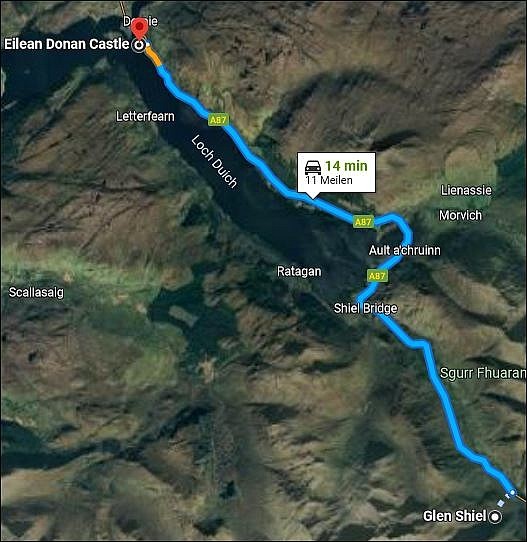
Das Bild von Eilean Donan Castle, wie es sich vor der Kulisse der Berge der Isle of Skye im ruhigen Wasser spiegelt, ist zum Inbegriff von Schottland geworden. Es ist das mit Abstand beliebteste Fotomotiv des Landes und Sinnbild des mystischen Schottlands.

Eilean Donan Castle thront auf einer kleinen Insel, die bei Flut komplett vom Meer umspült wird. Die Lage ist malerisch und strategisch zugleich. Eilean Donan liegt genau am Treffpunkt dreier Meerbusen.

Man meint förmlich, die Geschichte atmen zu können und über die Brücke, die zur Burg führt, eine Zeitreise in die Vergangenheit unternehmen zu können.

Von der Isle of Skye im Westen kommt das Loch Alsh, das dann nach Süd-Osten abknickt und von da an Loch Duich heißt. Loch Duich reicht dabei tief ins Landesinnere, bis hin zur Shiel Bridge. Oberhalb der Burg verläuft schließlich noch das schmale Loch Long.
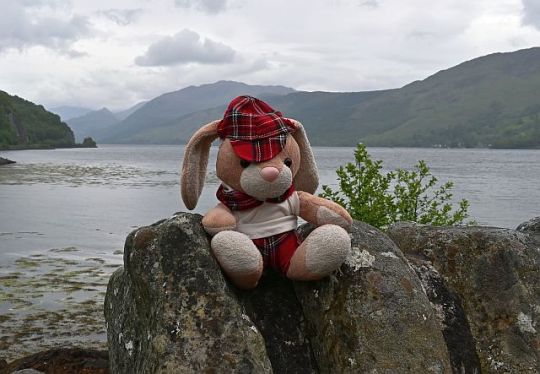
Wer diese Lochs mit dem Schiff befahren wollte, um in das Landesinnere zu kommen, der musste zuerst an Eilean Donan Castle vorbei. Genau das machte die Burg so wertvoll.

Übersetzt heißt der gälische Name „Donans Insel“. Man glaubte, dass auf dem kleinen Eiland einige Zeit der Heilige Donnán von Eigg lebte, ehe er 617 von einer piktischen Königin verbrannt wurde. Belege dafür lassen sich allerdings nicht finden.

Später wurde Donans Insel zum Stammsitz des schottischen Clans der Macrae. 1220 ließ Alexander II. von Schottland an dieser Stelle eine Burg errichten, die in der schottischen Geschichte eine ruhmreiche Rolle gespielt haben soll, als Robert the Bruce (der Thronanwärter aus „Braveheart“) hier Zuflucht fand, als er vor den Engländern floh.

In den folgenden Jahrhunderten unterlag die Burg ständigen Veränderungen, An-, Um- und Neubauten, sodass sie ihr Gesicht mindestens vier Mal vollständig veränderte.
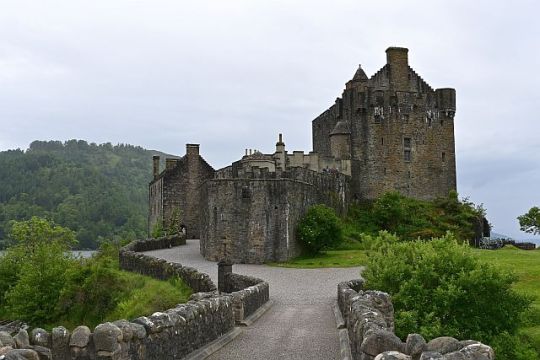
Im Jahr 1719 dann zerstörten drei englische Fregatten Eilean Donan Castle. Die Schiffe müssen damals über Kyle Akin am Kyle of Lochalsh gekommen sein und die Burg, die zu diesem Zeitpunkt spanischen Truppen als Garnison diente, zerstört haben.

Sechsundvierzig spanische Soldaten, die die jakobitische Sache unterstützten, waren in der Burg stationiert und wurden dort getötet. Ein Geist, der oft gesehen wird, soll einer dieser Soldaten sein – er wird mit dem Kopf unter dem Arm im heutigen Souvenirshop gesehen. Eine weibliche Erscheinung wird angeblich auch gesehen, wie sie durch die Schlafzimmer wandert.

200 Jahre lang lag Eilean Donan Castle anschließend in Ruinen. Erst 1911 fasste sich Lieutenant Colonel John MacRae-Gilstrap ein Herz, erwarb die Insel und begann schon ein Jahr später mit dem langen und sehr mühsamen Wiederaufbau des Castles.
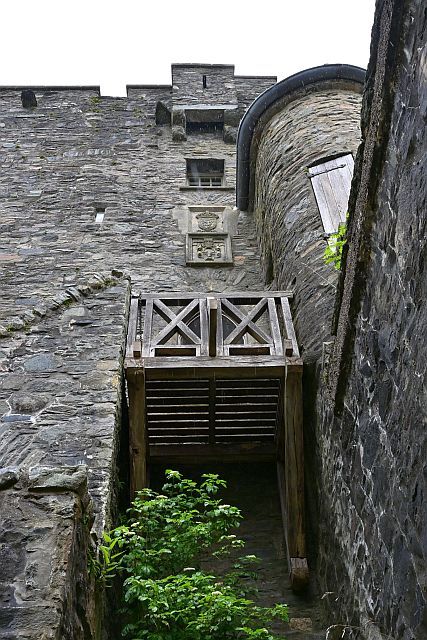
20 Jahre sollte es dauern, bis Eilean Donan Castle in neuem Glanz wiedereröffnet werden konnte und es ist vor allem dem Geschick des Rekonstrukteurs zu verdanken, dass Eilean Donan Castle aussieht, als hätte die Burg schon seit Jahrhunderten unverrückbar an dieser Stelle gestanden.

Nach dem Tod von John MacRae-Gilstrap im Jahr 1937 blieb das Schloss lange unbewohnt. 1955 wurde das Eilean Donan Castle von Mr John MacRae, dem Enkel von John MacRae-Gilstrap, als Museum für Besucher eröffnet. Die Burg ist auch heute noch Stammsitz des schottischen Clans der Macrae.
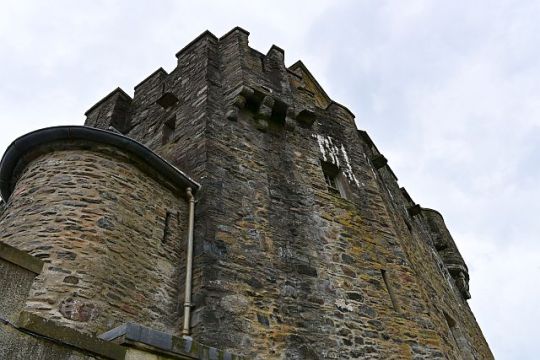
Seitdem gilt die Burg als Besuchermagnet und zählt zu den wichtigsten Touristenattraktionen Schottlands. Sie ist der Inbegriff schottischer Romantik geworden und ein Fotomotiv, das man schöner kaum finden kann. Dennoch – oder vielleicht gerade deshalb – ist das Castle auf jeden Fall einen Besuch wert.

Auf die Insel, gelangt man zu nur über eine langgezogene und wunderschöne steinerne Brücke. Bei Flut ist das Schloss übrigens komplett von Wasser umgeben. Diese Brücke und das düstere Gemäuer dahinter hat Eilean Donan berühmt gemacht, denn sie diente immer wieder als Filmkulisse.

Highlander mit Christopher Lambert aus dem Jahre 1986 hat Eilean Donan mit seiner Brücke weltberühmt gemacht. Eigentlich ist die Szene nur sehr kurz, die dort spielt: Der Clan MacLeod zieht in den Krieg aus und reitet über die Steinbrücke, im Hintergrund erhebt sich das Gemäuer der Burg. Doch war das wohl eine der prägenden Szenen des Streifens, denn danach wollten plötzlich so viele Menschen diese Burg mit der außergewöhnlichen Brücke sehen.
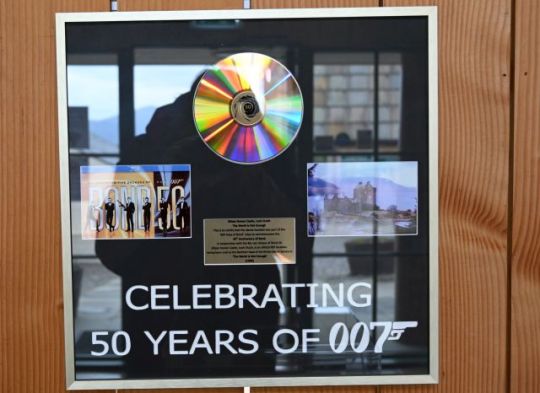
Besuch eines bekannten Geheimagenten erhielt Eilean Donan 1999. Denn im James Bond Film „Die Welt ist nicht genug“, verschlägt es Pierce Brosnan als 007 auch nach Schottland – und wo sonst als in der Eilean Donan Castle sollte das Hauptquartier des MI6 residieren?
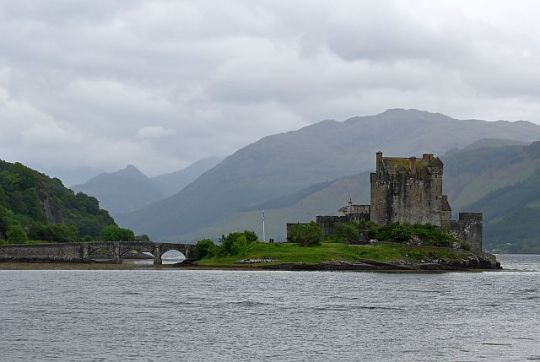
Und dann gab es noch exotischen Besuch aus Bollywood. Im Film „Kuch Kuch Hota Hai“ mit Superstar Shah Rukh Khan taucht Eilean Donan plötzlich als Kulisse für einen der typischen Songs im indischen Kino auf.
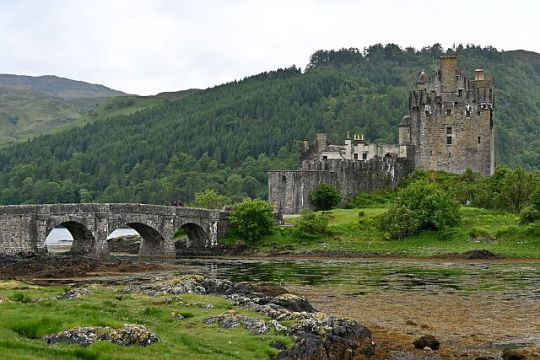
Weitere Filme, die teilweise hier spielten: „Bonnie Prince Charlie“ mit David Niven, „Der Freibeuter“ mit Errol Flynn und „Nessie – Das Geheimnis von Loch Ness“.

Natürlich kennt man Eilean Donan Castle aus „Braveheart“, aber auch aus „Rob Roy“ und „Verliebt in die Braut“. Einige Szenen für „Elizabeth – Das goldene Königreich“ und den Thriller „Verlockende Falle“ mit Sean Connery und Catherine Zeta-Jones wurden hier ebenfalls gedreht.

Eilean Donan ist eine schottische Touristen-Attraktion erster Güte, entsprechend groß ist der Rummel. Die Maschinerie der Vermarktung läuft professionell und wie geschmiert. Die Parkplätze sind riesig und immer voll besetzt.

Schon von weitem bietet das Schloss eine unglaublich tolle Fotokulisse. Es lohnt sich auch, auf die nahe Straßenbrücke zu gehen und das Schloss aus dieser Perspektive anzuschauen. Die Straße ist zwar stark befahren, aber es gibt einen breiten Gehweg. Der Blick von hier auf das Schloss ist wirklich toll.

Natürlich ist das Eilean Donan Castle auch von Innen absolut spektakulär. Der Eintritt in das Schloss von 10 Pfund ist jeden Penny wert. Der empfehlenswerte Audioguide kostet noch einem 3 Pfund extra und ist auch in deutscher Sprache verfügbar. Man kann sich aber auch einer der vielen Gruppen, die durchs Castle geschleust werden, diskret anschließen und mitlauschen.

Die Führungen werden gekonnt inszeniert werden. Mit dem Kilt gekleidet, einem schottischem Zungenschlag und viel Herzblut erzählen die Guides die Geschichte der Burg, führen durch die üppigen Zimmer und die Geheimkammer im großen Saal.

Man erfährt sehr viel über die Geschichte des Schlosses, der Clans und von Schottland allgemein. Wer weiß denn schon welche Kilt-Farbe für welches Ereignis steht?

Es macht einfach Spaß, die vielen Räume zu entdecken und engen Wendeltreppen nach oben zu kraxeln. Kinder kommen im dem Schloss natürlich auch voll auf ihre Kosten. Man braucht nicht viel Fantasie, um sich in die Zeit der Ritter zurückzuversetzen.
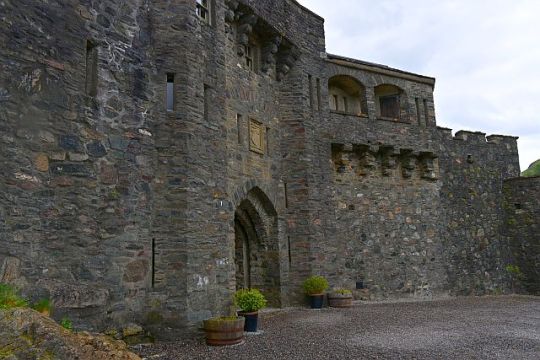
Nach dem Besuch kann man sogar einmal um die komplette Anlage laufen. In der Burg selber dürfen in den Zimmern allerdings keine Aufnahmen gemacht werden.

Ganz am Anfang der Rundtour durch das Eilean Donan Castle gibt es einen Ausstellungsraum in dem fotografiert werden darf. Außerdem gibt es den üblichen Mitarbeiter, der in Tracht gekleidet, für touristische Aufnahmen zur Verfügung steht.

Fototipp: Wieder auf der A87 nach Skye, über die Loch Long Brücke, gleich nach der Burg. Dahinter kommt links ein kleiner Parkplatz mit Anlegesteg für Boote. Von da aus kann man die Eilean Donan seitlich fotografieren.

Bei dem Loch Long handelt es sich um einen Meeresarm, der ähnlich wie ein Fjord gebildet wurde.
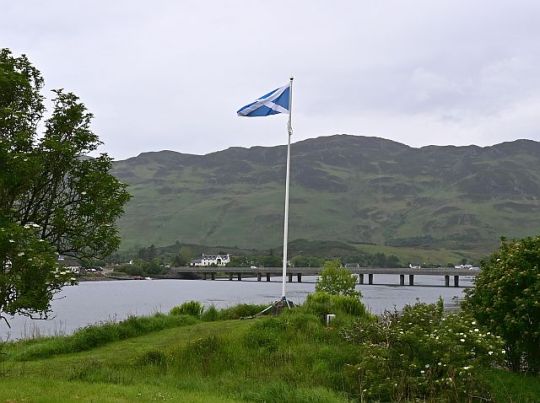
„Loch Long“ wird aus dem Gälischen als Schiffssee übersetzt, da Arrochar 1263 ein wichtiges Ziel für die Angriffe der Wikinger war. Sie schleppten ihre Boote 2 Meilen über Land nach Tarbet, um die ungeschützten Siedlungen im Landesinneren von Loch Lomond anzugreifen.

Die aktuelle Brücke, die Loch Long zwischen Dornie und Ardelve überspannt, wurde 1990 gebaut, um das ältere Bauwerk etwas weiter flussaufwärts zu ersetzen. Die neue Straße, die Carr Brae umgeht, war einige Jahre zuvor gebaut worden.

Vor dem Bau der Brücke im Jahr 1940 verkehrte eine Autofähre von Ardelve, die regelmäßig nach Dornie und auf Anfrage nach Totaig auf der Südseite von Loch Duich verkehrte. Es ist nur eine Autofähre bekannt, die auf diesem Dienst gefahren ist, obwohl eine Fährverbindung hier bereits seit mehr 2 Jahrhunderten verkehrte.
Die alte Brücke war eine eingleisige Betonkonstruktion, die sich von der Mitte des Dorfes Dornie bis unmittelbar nördlich der neuen Brücke auf der Ardelve-Seite erstreckte. Von der alten Brücke ist heute nichts mehr übrig, da sie kurz nach der Eröffnung der neuen Brücke komplett demontiert wurde. Die Hellingen der Airds-Fähre, die der Brücke vorausgingen, werden jedoch immer noch auf beiden Seiten des Loch Long benutzt.
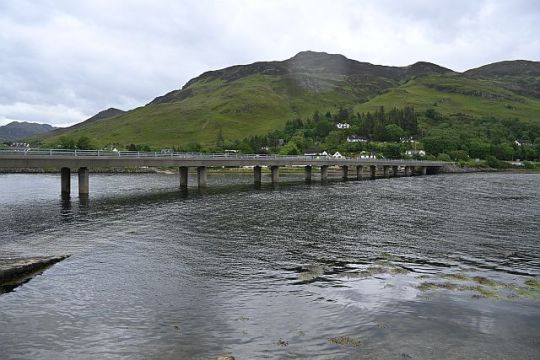
Die neue Brücke über Loch Long wurde 1990 eröffnet und bietet anstelle der schmaleren alten Struktur eine zweispurige Straße in beide Richtungen. Die Brücke besteht aus zehn Spannweiten über dem Fluss, die von Betonpfeilern unter dem Deck getragen werden.
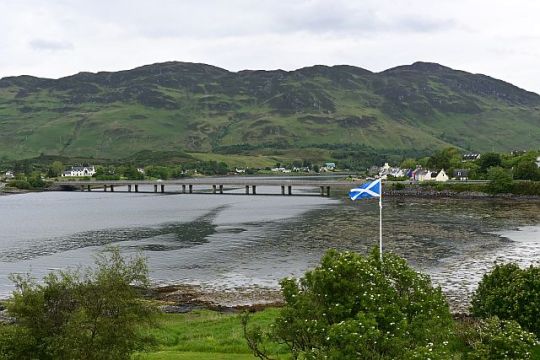
Die A 87 folgt von hier dem Loch Alsh. Loch Alsh (vom schottisch-gälischen Loch Aillse, „schäumender See“) ist eine Meeresbucht zwischen der Insel Skye und den nordwestlichen Highlands von Schottland.
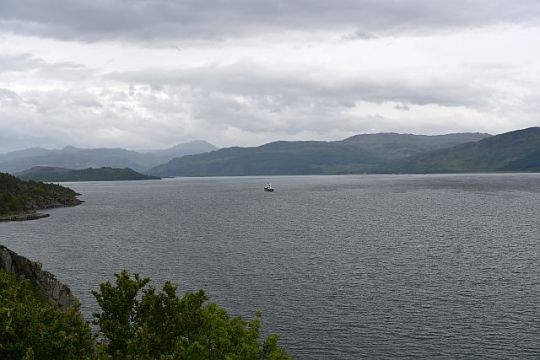
Der Name wird auch verwendet, um das umliegende Land und die feudalen Besitzungen rund um den See zu beschreiben. Die Gegend ist reich an Geschichte und wird bei Touristen immer beliebter.

Der See verläuft etwa 12 Kilometer landeinwärts bis zum Eilean Donan Castle.
Eine schmale Meerenge südlich von Loch Alsh führt zum Sound of Sleat, der die Isle of Skye vom Festland trennt. Die urzeitlichen Felsen rund um Loch Alsh wurden durch eine Reihe von Eiszeiten stark erodiert.
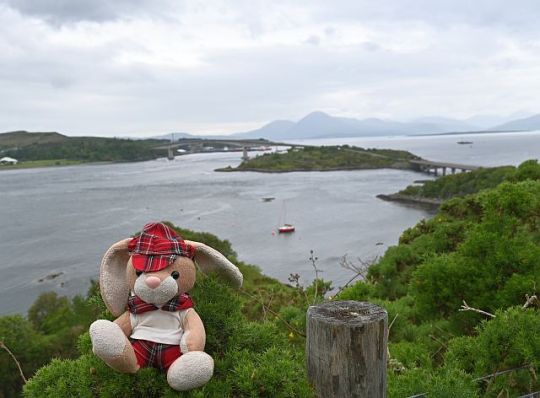
Einst ist der Wald hier ausgedehnter gewesen, aber die frühen Bewohner wandelten Teile davon in Crofts (kleine Farmen) um, und als die Highland Clearances die Crofts zerstörten, wurde das Land als Weide erhalten.

Kyle of Lochalsh (gälisch: Caol Loch Aillse) ist ein Ort an der Nordwestküste Schottlands. Der Ort liegt etwa 100km westlich von Inverness und gehört zum County Area Highland.

Kyle Of Lochalsh liegt am Eingang des Loch Alsh gegenüber des Ortes Kyleakin, der auf der Isle Of Skye liegt. Das machte Kyle Of Lochalsh sehr bekannt, da man früher nur per Fähre von Kyle Of Lochalsh auf die Isle of Skye kam.

Das ist jedoch Geschichte. Seit 1995 befindet sich die Skye Bridge in Betrieb, der Fährbetrieb wurde deshalb eingestellt. Die Skye Bridge befindet sich ca. 2 km entfernt vom Ort.
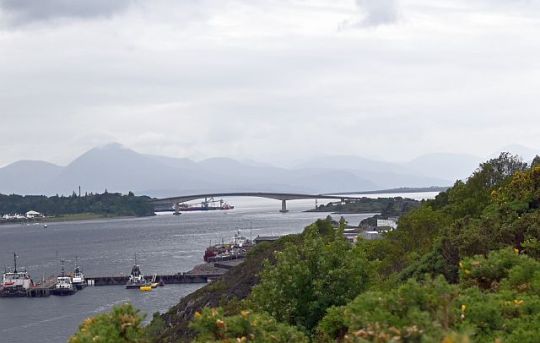
Seit Dezember 2004 ist die Brücke für alle frei, aber das war nicht immer so. Als die Brücke 1995 eröffnet wurde, erhob man für beide Richtungen eine teure Mautgebühr.

Der Brückenbau begann 1992, gebaut von der schottischen Firma Miller, aber entworfen von dem deutschen Ingenieurbüro DYWIDAG Systems aus Langenfeld.

Die Hauptbrücke ist ein Betonbogen, der von zwei Pfeilern getragen wird. Diese verbinden Skye mit der kleinen Insel namens Eilean Bàn, der Rest der Brücke verläuft auf gleicher Höhe mit dem Festland. Die Gesamtstrecke beträgt 1,5 Meilen (2,4 km). Der Hauptbogen ist etwa 35 m hoch (30 m Abstand für Boote bei Flut).

Die meisten Menschen wollten die Brücke, aber die Art und Weise, wie sie finanziert wurde, löste eine Kontroverse. Die britische Regierung konnte und wollte nicht für die Kosten aufkommen und so sprangen private Geldgeber ein. Anschließend wurde dem privaten Unternehmen eine Lizenz zur Erhebung von Mautgebühren erteilt. Sie galt als die teuerste Straßenbrücke Europas.

Die Bewohner auf Skye gründeten eine Kampagnengruppe namens SKAT (Skye and Kyle Against Tolls). Nach jahrelangen Kampagnen, rechtlichen Herausforderungen und der Gründung des neuen schottischen Parlaments im Jahr 1999 machten die führenden politischen Parteien die Abschaffung der Maut zu ihrer Priorität. Am 21. Dezember 2004 wurde die Brücke von der schottischen Regierung aufgekauft und anschließend frei befahrbar gemacht.
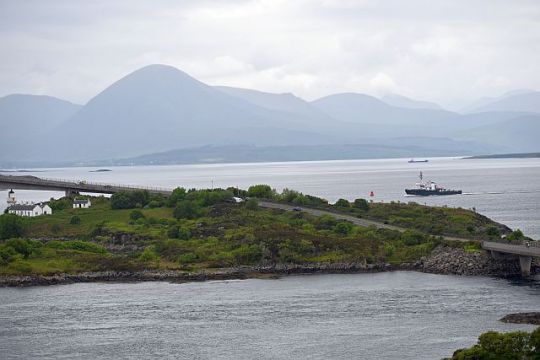
Eilean Bàn (Weiße Insel) ist die kleine Insel, auf der der Hauptbogen der Brücke ruht.
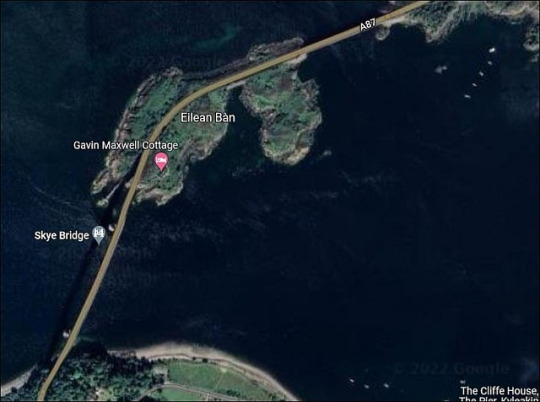
Die Insel hat einen 21 m hohen Leuchtturm direkt unter dem Brückenbogen. Die Leuchtturmwärter (vor der Automatisierung in den 1960er Jahren) blieben in den Cottages auf der Insel. Heutzutage ist die Insel ein Naturschutzgebiet, das vom Bright Water Trust verwaltet wird.
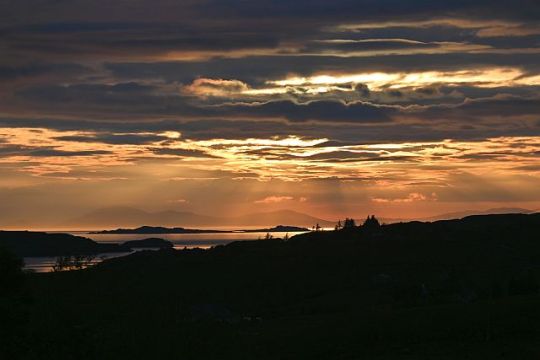
Wir fahren noch rund 1 Stunde über die Isle of Skye, bis wir an unserem Cottage gegen 18 Uhr eintreffen. Am späten Abend werden wir mit einem sensationellen Sonnenuntergang belohnt.
Oidhche mhath!
Angie, Micha und Laird Hasenbär
6 notes
·
View notes
Text
beautiful places in the UK outside of London

Michal 11 / Shutterstock
Whether you live in the UK or are planning your first trip, it can be easy to go back to the same London-centric spots when you’re looking for a day out or weekend away.
To help you expand your horizons, Instagram data tool Magi Metrics has gathered data from hashtags and geotagged locations on Instagram in order to locate the most popular beauty spots in the UK — London not included. The data was collected by looking at locations in the UK outside of London where users had posted the hashtags #beautiful, #stunning, #wonderful, #romantic, and #lovely. After analysing more than 300,000 posts, they came up with this list - scroll down to check it out.
Cleethorpes Beach, Lincolnshire, England.

Simon O'Neill Photography / Shutterstock
The most popular beautiful spot in the UK outside of London is one you may not have heard of. Cleethorpes, the quaint British seaside resort, is the most loved by Instagram users, with its beach topping the list thanks to its miles of sand, and the award-winning gardens along the promenade.
Edinburgh Castle, Edinburgh, Scotland.

Michal 11 / Shutterstock
It may sit right in the middle of the city, but Edinburgh Castle, home to the Scottish Crown Jewels, is still gorgeous, and offers a perfect view of the surrounding area.
Giant’s Causeway, County Antrim, Northern Ireland.


Step back in time with this often-photographed landmark, which is Northern Ireland’s first UNESCO Heritage Site. According to legend, the columns are the remains of a causeway built by a giant. The story goes that the Irish giant Fionn mac Cumhaill (Finn MacCool), from the Fenian Cycle of Gaelic mythology, was challenged to a fight by the Scottish giant Benandonner. Fionn accepted the challenge and built the causeway across the North Channel so that the two giants could meet. In one version of the story, Fionn defeats Benandonner. In another, Fionn hides from Benandonner when he realises that his foe is much bigger than he is. Fionn’s wife, Oonagh, disguises Fionn as a baby and tucks him in a cradle. When Benandonner sees the size of the ‘baby’, he reckons that its father, Fionn, must be a giant among giants. He flees back to Scotland in fright, destroying the causeway behind him so that Fionn would be unable to chase him down. Across the sea, there are identical basalt columns (a part of the same ancient lava flow) at Fingal’s Cave on the Scottish isle of Staffa, and it is possible that the story was influenced by this.
Durdle Door, Dorset, England.

Pete Lamb
Eroded by time and nature, Durdle Door is one of Dorset’s most photographed and iconic landmarks. It is located on the Lulworth Estate in south Dorset and is part of the Jurassic Coast. The coastline is of such international geological importance that it was designated England’s first natural World Heritage Site by UNESCO in 2001 and is now part of a family of natural wonders including America’s Grand Canyon and Australia’s Great Barrier Reef. The magnificent natural limestone arch was formed when the power of the waves eroded the rock and forged a hole through the middle. The name Durdle is derived from an old English word ‘thirl’, which means to pierce, bore or drill.
Eilean Donan Castle, Highland, Scotland.

The original castle was built in 1220 for Alexander II as a defence against the Vikings. In medieval times the castle had towers and a curtain wall that covered nearly the whole island. By the late 13th century it was owned by the Mackenzies of Kintail (later the Earls of Seaforth). In 1511, the MacRaes became custodians of the castle, as protectors of the MacKenzies. Over the centuries the castle has been rebuilt at least four times. Eilean Donan was partially destroyed in a Jacobite uprising in 1719. The castle lay in ruins for almost 200 years until Lieutenant Colonel John MacRae-Gilstrap bought the island in 1911, and spent the next 20 years restoring the castle. The restoration included the construction of an arched bridge to give easier access to the castle The castle was re-opened in 1932.
Arthur’s Seat, Edinburgh, Scotland.

S-F / Shutterstock
Arthur’s Seat is an extinct volcano which is the main peak of the group of hills in Edinburgh, Scotland, which form most of Holyrood Park, described by Robert Louis Stevenson as “a hill for magnitude, a mountain in virtue of its bold design”. It is situated just to the east of the city centre, about 1 mile (1.6 km) to the east of Edinburgh Castle. The hill rises above the city to a height of 250.5 m (822 ft), provides excellent panoramic views of the city and beyond, is relatively easy to climb, and is popular for hillwalking. Though it can be climbed from almost any direction, the easiest and simplest ascent is from the east, where a grassy slope rises above Dunsapie Loch.
Stonehenge, Wiltshire, England.

Gail Johnson / Shutterstock
The most famous prehistoric monument in Europe, this wonder of the world is a must-see outside of London. For centuries, historians and archaeologists have puzzled over the many mysteries of Stonehenge, the prehistoric monument that took Neolithic builders an estimated 1,500 years to erect. Located in southern England, it is comprised of roughly 100 massive upright stones placed in a circular layout. While many modern scholars now agree that Stonehenge was once a burial ground, they have yet to determine what other purposes it served and how a civilisation without modern technology—or even the wheel—produced the mighty monument. Its construction is all the more baffling because, while the sandstone slabs of its outer ring hail from local quarries, scientists have traced the bluestones that make up its inner ring all the way to the Preseli Hills in Wales, some 200 miles from where Stonehenge sits on Salisbury Plain.
Blenheim Palace, Oxfordshire, England.

Fulcanelli / Shutterstock

hali.com
Blenheim Palace, residence near Woodstock, Oxfordshire, England, built (1705–24) by the English Parliament as a national gift to John Churchill, 1st duke of Marlborough. During the War of the Spanish Succession, he had led the English to victory over the French and Bavarians at the Battle of Blenheim in Germany in 1704. The palace was designed by Sir John Vanbrugh, with a great deal of involvement by Nicholas Hawksmoor, and is regarded as the finest example of truly Baroque architecture in Great Britain.
Snowdonia, Gwynedd, Wales.

Lilly Trott / Shutterstock

Snowdonia National Park, Welsh Parc Cenedlaethol Eryri, national park in Gwynedd county and Conwy county borough, northern Wales, with an area of 838 square miles (2,171 square km). It is best known for its mountains, composed largely of volcanic rock and cut by valleys that show the influence of Ice Age glaciers. Snowdon mountain’s summit, Yr Wyddfa, in the northwestern part of the park, is the highest peak in England and Wales, with an elevation of 3,560 feet (1,085 metres). A rack-and-pinion railway (opened 1896) runs from Llanberis to the summit. Farther south Cader Idris (“Chair of Idris”), a long mountain ridge, reaches a height of 2,927 feet (892 metres) at Pen-y-Gader.
Chatsworth House, Derbyshire, England.

david muscroft / Shutterstock

Chatsworth, estate near Rowsley, Derbyshire Dales district, administrative and historic county of Derbyshire, England, containing the principal seat of the English dukes of Devonshire. Chatsworth House itself stands near the left bank of the River Derwent. Construction of the original building began in 1553, but, after suffering occupation by both parties to the English Civil Wars of the mid-17th century, this house was subsequently demolished. The present mansion, often called “Palace of the Peak,” was designed by William Talman for William Cavendish, the 4th earl (created 1st duke of Devonshire, 1694), and was begun in 1687. The 6th duke made various additions, including the long north wing (1820–27). The house has a library and an art collection with many masterpieces in it. The formal gardens that surround the house were designed by Sir Joseph Paxton, and the estate’s park is more than 11 miles (18 km) in circumference.
Chester Zoo, Chester, England.

SteveSimonsPhotography / Shutterstock
Home to over 21,000 endangered and exotic animals, the most visited zoo in the UK also makes the list of the most beautiful places.
Cliffs Of Dover, Kent, England.

Platslee / Shutterstock

Dover, town (parish) and seaport on the Strait of Dover, Dover district, administrative and historic county of Kent, southeastern England. Situated on the English Channel at the mouth of a valley in the chalk uplands that form the famous white cliffs, Dover is the closest English port to the European mainland. It serves as the administrative centre for the district. A pre-Roman settlement existed on the site, and, as Dubris, the place was important for Roman traffic with the European mainland. In the 4th century CE it was guarded by a fort as part of the defenses of the Saxon Shore. The castle, which stands 375 feet (114 metres) above sea level and from which on a clear day the coast of France can be seen, dominates the town below. Within its precincts are a Roman lighthouse, the ancient fortress Church of St. Mary in Castro, remains of the Saxon stronghold, and the massive Norman keep. During the 11th century it was made one of the Cinque Ports. Dover claims to be a Saxon borough by “prescription,” without a formal charter of incorporation.
Lulworth Cove, Dorset, England.

Kevin Eaves / Shutterstock

One of the most famous landforms in the country, you can enjoy panoramic views and crystal-clear waters with a visit to this UNESCO World Heritage Site. On the Jurassic Coast, a fossil’s throw from quaintly named Durdle Door, Lulworth Cove is a sheltered shell-shaped oasis edged with white pebbles. The impressive rock formations along this varied stretch of shoreline represent 185 million years of Earth’s history, and while the small cluster of pubs and places to stay that surround Lulworth Cove might not have been around quite that long, they are satisfyingly far from modern.
Dunnottar Castle, Aberdeenshire, Scotland.

elementals / Shutterstock
Standing upon a striking headland, surrounded by almost sheer cliffs on three sides, Dunnottar is not only one of the most beautiful medieval fortresses in Britain, but the site of some of the most fascinating and dramatic events in British history.
Over the turbulent centuries, it has been burned, rebuilt, and burned again. It has been besieged, visited by saints and queens, and been the setting for dramatic escapes. It has been a religious community, a fortress, a terrible prison, and the scene of one of the most famous episodes in the story of Scotland. There may have been prehistoric settlements at Dunnottar, but the earliest historic record comes from the 5th century when the tireless Celtic saint Ninian established a church on the Rock of Dunnottar, one of the earliest Christian sites in Pictland.
Loch Ness, Highlands, Scotland.

Bucchi Francesco / Shutterstock

Loch Ness, lake, lying in the Highland council area, Scotland. With a depth of 788 feet (240 metres) and a length of about 23 miles (36 km), Loch Ness has the largest volume of fresh water in Great Britain. It lies in the Glen Mor—or Great Glen, which bisects the Highlands—and forms part of the system of waterways across Scotland that civil engineer Thomas Telford linked by means of the Caledonian Canal (opened 1822). Like some other very deep lochs in Scotland and Scandinavia, Loch Ness is said to be inhabited by an aquatic monster. Many sightings of the so-called Loch Ness monster have been reported, and the possibility of its existence—perhaps in the form of a solitary survivor of the long-extinct plesiosaurs—continues to intrigue many.
https://www.businessinsider.com/history.com/britannica.com
Thank you...very cool!😊❤️❤️❤️❤️
41 notes
·
View notes
Photo
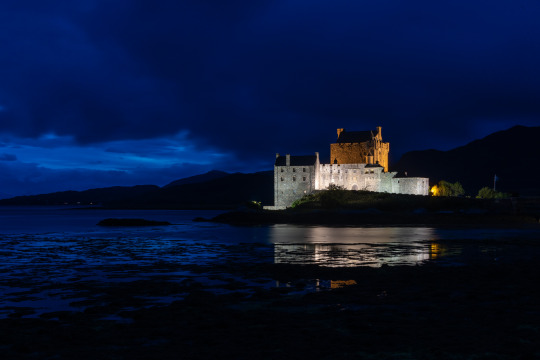

The name Eilean Donan, or the Island of Donan was likely named after the Irish Saint, Bishop Donan, who came to Scotland circa 580 AD and likely set up a small community there. The small tidal island where three sea lochs meet (Loch Duic,Loch Long and Loch Alsh), was first fortified to withstand the Vikings in the thirteenth century. The site grew into a large castle, covering the whole of the island but at the end of the fourteenth century, the castle was reduced to about a fifth of this size. Eileen Donan’s part in the Jacobite risings of the seventeenth and eighteenth centuries ultimately lead to its demise, and for nigh on the next two hundred years, the castle lay in ruins. In 1911, Lt. Colonel John Macrae-Gilstrap bought the island, rebuilding the castle using earlier plans and completing the building in 1932.
#eileandonan#eilean donan castle#islandofeilean#westcoast#kyleoflochalsh#blueskyatnight#scotland#islagoldiephotography#nightphotography#scottishcastle#fortress
1 note
·
View note
Photo

Eilean Donan Castle
Eilean Donan Castle perches on a tidal island where three sea lochs—Loch Duich, Loch Long, and Loch Alsh—meet, seen here in an aerial view with the Isle of Skye in the distance. There have been four fortified castles on this spot since the 13th century, but the site was left in ruins following the Jacobite Uprising in 1719. Lieutenant Colonel John MacRae-Gilstrap is the one to thank for the restored castle you can visit today. He bought the island in 1911 and embarked on a grueling 20-year restoration.
10 notes
·
View notes
Photo

Eilean Donan (Scottish Gaelic: Eilean Donnain) is a small tidal island where three sea lochs meet, Loch Duich, Loch Long and Loch Alsh, in the western Highlands of Scotland. A picturesque castle that frequently appears in photographs, film and television dominates the island, which lies about 1 kilometre (5⁄8 mi) from the village of Dornie. Since the castle's restoration in the early 20th century, a footbridge has connected the island to the mainland. Eilean Donan is part of the Kintail National Scenic Area, one of 40 in Scotland. In 2001, the island had a recorded population of just one person, but there were no "usual residents" at the time of the 2011 census. Eilean Donan, which means simply "island of Donnán", is named after Donnán of Eigg, a Celtic saint martyred in 617. Donnán is said to have established a church on the island, though no trace of this remains. The castle was founded in the thirteenth century, and became a stronghold of the Clan Mackenzie and their allies the Clan MacRae. In the early eighteenth century, the Mackenzies' involvement in the Jacobite rebellions led in 1719 to the castle's destruction by government ships. Lieutenant-Colonel John Macrae-Gilstrap's twentieth-century reconstruction of the ruins produced the present buildings. #dreamdestinations #castle (at Eilean Donan Castle) https://www.instagram.com/p/CIXBxpFlGZ0E7uAODV8IBwbNFlBKc-SktDtBaU0/?igshid=cikyj0u82raj
0 notes
Photo


Eilean Donan Castle, western Highlands
© CBW/Alamy
*
Featured on Bing
25 November 2020
Bridging the centuries
Located at the meeting point of three sea lochs, Eilean Donan Castle is just the latest in a line of monastic cells and clan strongholds constructed on this small island since the 7th century. The first fortified castle was built in the 13th century to defend against invading Vikings who occupied much of the north of Scotland and the Western Isles at the time.
From the 14th to the 18th centuries, the castle was mostly held by the Mackenzies and defended by the Macraes, both Highland clans, but it was destroyed by the Royal Navy during the 1719 Jacobite Rising.
Centuries later, it was rebuilt along the lines of its earlier design after the island was bought by Lt Colonel John Macrae-Gilstrap in 1911. He and his clerk of works Farquar Macrae spent 20 years restoring the ruined castle to her former glory. The picturesque castle surrounded by stunning scenery is recognised as an iconic image of Scotland all over the world.
*
Eilean Donan Castle in Scotland
Today on Bing
November 30, 2020
A water loch-ed castle
Located on a small island where three sea lochs meet in northwestern Scotland, the current Eilean Donan Castle is just the latest incarnation of several monastic cells and Scottish clan strongholds that have occupied the small island since the 7th century. The first fortified castle was built in the 13th century to defend against invading Vikings who occupied much of Scotland at the time. An iconic symbol of Scotland, from the 14th-18th centuries, the castle was mostly held by the Mackenzies and defended by the Macraes, both storied clans of the Scottish Highlands. The castle was destroyed in 1719 by the invading British Royal Navy during the Jacobite Uprising, but was rebuilt along its earlier design in the early 20th century by Lt. Colonel John Macrae-Gilstrap.
*
Today on Bing
November 30, 2020
A water loch-ed castle
Located on a small island where three sea lochs meet in northwestern Scotland, the current Eilean Donan Castle is just the latest incarnation of several monastic cells and Scottish clan strongholds that have occupied the tidal islet since the 7th century. The first fortified castle was built in the 13th century to defend against invading Vikings who occupied much of Scotland at the time. An iconic symbol of Scotland, from the 14th to 18th centuries the castle was mostly held by the Mackenzies and defended by the MacRaes, both storied clans of the Scottish Highlands. The castle was destroyed in 1719 by the invading British Royal Navy during the Jacobite Uprising, but was rebuilt along its earlier design in the early 20th century by Lt. Colonel John MacRae-Gilstrap.
0 notes
Text

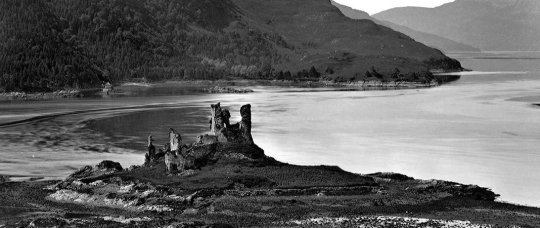

On 13th April 1719 a small Spanish force, believing itself to be part of a much larger invasion planned for England to return the Jacobites to power, landed in Loch Duich, east of the site of what is now Kyle of Lochalsh.
The little known 'Little Rising’, saw a force of 300 Spanish soldiers land and combine with less than a thousand Highlanders, under George Keith, the 10th Earl of Marischal, William Mackenzie, the 5th Earl of Seaforth Lord George Murray and John Cameron of Lochiel.
The plan had been hatched by King Philip of Spain and Italian Cardinal Alberoni as a diversion to help in the campaign to restore Spanish power and territories ceded to the British following the Treaty of Utrecht. The Spanish force should have been much larger, but much of it had been destroyed by a storm. Added to this Highlanders did not join the Jacobites in the expected numbers, However, the Jacobites made their base at Eilean Donan Castle and intended to capture Inverness. Unfortunately, Hanoverian ships shelled the castle and the only battle was at Glen Shiel two months later when the Jacobites were defeated by a Government army led by General Joseph Wightman.
This uprising is often overlooked, the only “major” action was on June 10th at the Battle of Battle of Glen Shiel, more of that in a couple of months.
A wee added note to this, it was during this time that Eilean Donan was destroyed by Government ships bombarding it the ruined castle was abandoned until 1912 when it was purchased by Lieutenant-Colonel John MacRae-Gilstrap. Rebuilding was undertaken between 1914 and 1932 and it was at this time that a bridge was built to link the island to the shore. The pics shows how the castle looked in the two centuries between these events and the restoration, and the ruin, as it was.
40 notes
·
View notes
Text






18 september
Het wegennet in the Highlands is niet groot te noemen, maar daar waar je je kunt voortbewegen, daar word je getracteerd op ongekende natuurschoon. Aan het eind van de ochtend rijden we langs de oevers van Loch Ness, waar het monster zich vooralsnog koest houdt. Onlangs deed het verhaal de ronde dat het een paling zou zijn, maar dat is inmiddels in de ontkenningsfase. Dus wie weet....
Alras wordt de wereld onbewoonbaarder en bevinden wij ons op de weg die lijdt naar de eilandengroep van de Hebriden. De bergtoppen zijn omgeven door mist wat een mysterieus geheel geeft.
Dan uit de verte doemt een pittoresk kasteeltje op. De Eilean Donan Castle. Het is werkelijk schitterend te noemen, en heeft al vaak gediend als decor voor commercials, series en films. Tot begin jaren ‘20 was het een ruïne, en is toen weer opgebouwd in opdracht van kolonel John MacRae-Gilstrap. In 1932 was het klaar. In die jaren van de restauratie waren de ingrijpende gevolgen van de Eerste Wereldoorlog zeer voelbaar en zijn vrouw Ella, een Engelse die zoals zovele van haar landgenotes verliefd werd op het Schotse land en de oeroude gebruiken heeft ervoor gezorgd dat elke lid van de MacRae Clan, zowel de rijke als de arme tak die slachtoffer zijn geworden van deze oorlog genoemd worden in haar boek The Clan MacRae Rolls of Honour and of Service in The Great War.
Zachtjes valt de regen als wij de weg vervolgen naar Skye, een eiland van de Hebriden met een kleine 9.000 inwoners. Tweehonderd jaar geleden waren dat er nog meer dan 20.000, maar hongersnoden en emigratie naar Amerika hebben de daling ingezet. Via een ferry komen we weer op het ‘vaste’ land aan. Op het meer was het nog droog, maar nu regent het door laaghangende bewolking, wat echter wel een schilderachtig beeld oplevert. Voorbij een ander meer schijnt dan weer plots de zon. Hetgeen de rit gevarieerd en mooi maakt. In een land dat elke dag betovert wordt door het weer.
0 notes
Photo

Eilean Donan is recognised as one of the most iconic images of Scotland all over the world. Situated on an island at the point where three great sea lochs meet, and surrounded by some majestic scenery, it is little wonder that the castle is now one of the most visited and important attractions in the Scottish Highlands. Although first inhabited around the 6th century, the first fortified castle was built in the mid 13th century and stood guard over the lands of Kintail. Since then, at least four different versions of the castle have been built and re-built as the feudal history of Scotland unfolded through the centuries. Eilean Donan - canmore Partially destroyed in a Jacobite uprising in 1719, Eilean Donan lay in ruins for the best part of 200 years until Lieutenant Colonel John MacRae-Gilstrap bought the island in 1911 and proceeded to restore the castle to its former glory. After 20 years of toil and labour the castle was re-opened in 1932. https://www.eileandonancastle.com/about/ (at Eilean Donan Castle) https://www.instagram.com/p/B1FF2EkjiqG/?igshid=1fi63qnlb98jw
0 notes
Photo

From legend and lore, dramatic history and jaw-dropping architecture, these remarkable castles and citadels are spectacular destinations on our adventures. Join us to experience these regal ancient landmarks—and get a taste of royal life as we stay in an atmospheric château and a former palace of a maharaja.
Japan
On our adventure, Japan: Castles, Samurais, and Legends, we visit Okayama Castle, known as the “Castle of the Crow” because of its black exterior, as well as Himeji Castle, known as the “White Egret Castle” for its resemblance to a bird taking flight. Both are spectacular displays of Japanese castle architecture. Himeji Castle, the only UNESCO World Heritage Site in Japan, is a network of 83 buildings built in the mid-14th century that have never been damaged by war, earthquake, or fire.
View Japan: Castles, Samurais, and Legends Itinerary
Czech Republic
Imposing turrets, dramatic castle walls, and a history steeped in legend—the Czech Republic is what fairytales are made of. On our journey, From Bratislava to Prague, we explore the 13th century Cesky Krumlov Castle, set picturesquely in a river’s bend, with incredible Gothic, Renaissance, and baroque features. In northern Prague, another fairytale complex emerges: The Prague Castle. One of the largest castle complexes in the world and spread over 18 acres, the Prague Castle is comprised of spectacular courtyards, gardens, and historic buildings and has been the official residence of the Head of State since the 9th century.
View From Bratislava to Prague Itinerary
India
What was once the former home of the Maharaja of Jaipur is now a lovely hotel that we get to call home while on our Royal Rajasthan cultural tour. Built in 1835, the palace offers a grand entrance—by horse-drawn carriage—and each of its 78 guest rooms are all fit for royalty. You’re likely to see peacocks roam the gardens during sunrise and sunset and the atmospheric hotel bar is a wonderful place to enjoy a nightcap.
View Royal Rajasthan Itinerary
France
The medieval citadel, La Cité, of Carcassone, is absolutely extraordinary. Its massive walls—nearly two miles around—encircle more than 52 towers, a wonderfully preserved Gothic church, and marvelous historic buildings. On our Hiking in the Land of the Cathars adventure, we explore this site by day, and later retreat to our hotel set inside the city walls, right next to the Grand Basilica.
View Hiking in the Land of the Cathars Itinerary
Spend a night like royalty at the exquisite Château de la Treyne, one of the highlights of our journey, Prehistoric Caves and Great Cuisine of Southern France. This 14th century château has a magical setting overlooking the Dordogne River and is surrounded by a formal French garden lined with century-old cedars and nearly 300 acres of private forest. With 17 uniquely designed rooms, the château offers an authentic glimpse into what life was like in a French palace.
View Prehistoric Caves and Great Cuisine of Southern France Itinerary
Romania
Built in the 19th century, this Romanian castle, Pele’s Castle, was by far the most modern of its time. In fact, it was the first European castle entirely lit by the use of electricity. The castle was the summer residence of the royal family and boasts 160 rooms. Its gardens are equally marvelous, and we explore them on our Bulgaria to Transylvania adventure.
View Bulgaria to Transylvania Itinerary
Peru
With its zigzagging terraces and ceremonial buildings laid out in alignment with the movement of the sun, Choquequirao is the more mysterious (and far less-traveled) sister to Machu Picchu. Discoveries are still being made at this intriguing site, and we’ll camp right inside the walls on our expedition, Choquequirao: Trek to the Cradle of Gold. In the stillness and remoteness here, surrounded by snow-capped mountains, we will sense the majesty of the Inca Empire. One of our trip leaders has been a part of its excavations and will help unlock its wonders.
View Choquequirao: Trek to the Cradle of Gold Itinerary
Morocco
Beyond the bustling souks of Marrakesh and Fez stands the fortified village, or “ksar” of Ait Ben Haddou. This majestic UNESCO World Heritage Site has been the backdrop for many films, including Lawrence of Arabia. Our journey in Morocco takes us hiking up through the labyrinth of alleyways for breathtaking views of the dramatic Atlas Mountains and lush groves of palm trees.
View Morocco: Camels to Casbahs Itinerary
Scotland
During our explorations of Scotland’s Orkney Islands and Stunning North Coast, we visit Dunrobin Castle, a fairytale castle that is one of Britain’s oldest continuously inhabited houses—the Earl of the Clan Sutherland still retains private quarters here—and we’ll also be welcomed at Castle Leod, seat of Clan Mackenzie and home of their Chief, the Earl of Cromartie. We’ll have a visit with the Earl, learning about the tumultuous era of the Jacobite rebellion and infamous Highland Clearances, with a first-hand introduction to his 500-year-old family home.
View Scotland’s Orkney Islands and Stunning North Coast Itinerary
On our adventure to the Highlands and Islands of Scotland, we visit Eilean Donan Castle, one of the most recognizable sights in Scotland. Set on a tidal inlet where three lochs meet, it is connected by a footbridge to the mainland. Founded in the 13th century and a stronghold of the Clan Mackenzie, the castle also played a role in the Jacobite risings of the 17th and 18th centuries, ultimately leaving the huge stone structure in ruins. Lt. Colonel John Macrae-Gilstrap bought the island in 1911 and dedicated the next 20 years to its reconstruction.
View Highlands and Islands of Scotland Itinerary
Wales
Caernarfon Castle, a UNESCO World Heritage Site, is one of Edward I’s four castles built to control north Wales, collectively known as “The Iron Ring.” Perched on an estuary at the entrance to the Menai Strait, the well-preserved 13th century Caernarfon is undoubtedly the most impressive of the four, its massive stone structure a strong symbol of Edward’s military might. On our Adventure in Wales, we explore the impressive fortress that still plays an important part in British Royal life. It was here in 1969, with much pomp and ceremony, that young Prince Charles knelt before his mother, the Queen, to be invested as The Prince of Wales.
View Adventure in Wales Itinerary
0 notes
Photo

Eilean Donan (Eilean Donnain),
Dornie, Kyle of Lochalsh IV40 8DX, Scotland.
www.castlesandmanorhouses.com
Eilean Donan is a castle and small tidal island where three lochs meet, Loch Duich, Loch Long and Loch Alsh, in the western Highlands of Scotland. It was founded in the thirteenth century, and became a stronghold of the Clan Mackenzie and their allies the Clan Macrae.
Between 1919 and 1932 the castle was rebuilt by Lt. Col. John MacRae-Gilstrap. The restoration included the construction of an arched bridge to give easier access to the island.
77 notes
·
View notes